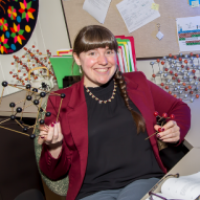SystemX Affiliates: login to view related content.

*To receive email announcements and live stream information for upcoming seminars, please subscribe to the SystemX Seminar/EE310 Mailing list here.
Modern metals manufacturing relies on centuries-old techniques that we must now revisit in light of global challenges in environmental and resource sustainability. Updating metals refinement, processing, and shaping requires new directions in the fundamental science underlying new aspects of these processes – beyond the trial-and-error routes of last millennium. My group studies the fundamental science underlying newly sustainable directions in metals manufacturing, enabled by our “modern toolbox” of characterization and computer-vision tools. I will begin this talk with an overview of our extensive work developing time-resolved dark-field X-ray microscopy (DFXM) – the first tool to directly “watch” the motion and interactions of dislocations deep inside metals over ms-fs timescales. This technique now enables direct measurements of microscopic origins of plasticity, failure, and annealing – which are essential to tune metals’ performance. Using this new framework, I will then present results showing a new view of how the stability of dislocation boundaries breaks down in single-crystal aluminum at near-melt temperatures that have long been inaccessible to theory and experiments. Shifting gears, I will describe our new fundamental work exploring the complex chemistry required to decarbonize the steelmaking process. While steel is ubiquitous in modern society, its refinement currently contributes 8% of the global CO2 footprint annually; 64% of this emission originates from the coal-based reduction of iron ores in the first step. Using X-ray diffraction and electron-microscopy, we reveal the kinetics and multiscale structural dynamics for H2-based direct iron reduction, demonstrating the first view of facet-dependent chemistry that couples to a mesostructural change from nanoparticles to elongated structures. Our finding shed light on the complex reaction dynamics of this system, paving the way for important insights into the energy-landscape of carbon-free steelmaking. Our science and new approaches to studying dislocations, metals separations, and processing offer key opportunities to redesign and advance sustainable manufacturing approaches required across industry.
In Sept 2021, Leora became an Assistant Professor in the Department of Materials Science and Engineering at Stanford, with a courtesy appointment in Mechanical Engineering and a term appointment in Photon Science at the SLAC National Accelerator Laboratory. She is also a Precourt Center Fellow for Sustainable Manufacturing. Leora did her postdoc from 2018-2021 as a Lawrence Fellow in the Physics Division at Lawrence Livermore National Labs. In that position, she led a large collaboration to develope the time-resolved version of dark-field X-ray microscopy to study dislocation patterning, recovery in metals, ultrahigh strength materials and radiation damage. Leora did her PhD from 2012-2018 in Physical Chemistry with Prof. Keith Nelson at MIT, where she demonstrated how shock waves initiate chemistry in RDX that couples to deformations in unique ways that enhance the sensitivity. During that work, she also developing the ultrafast microscope for the study, which took movies with 300 billion frames per second of how quasi-2D shock waves converge, and adapted computer vision methods to quantify the imaging results. Leora did her BA and MSc in Chemistry at the University of Pennsylvania.


